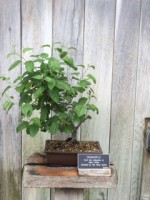 Crabapples are deciduous trees native to the temperate zones of the Northern Hemisphere. They belong to the rose family, Rosaceae, that also includes almonds, firethorn, and lady’s mantle. There are many species and cultivars of crabapples that vary in such characteristics as tree size, growth and branching habit, size, color of flower, and color of fruit. The flowers may be white, pink or cerise while the fruits may be green, yellow or red. Crabapples make excellent bonsai because they offer both flowers in spring and fruit in summer and fall as well as good foliage color in fall for some. When buying a crabapple bonsai avoid plants with scars or swellings of the graft union as the problem will only get worse and ruin the over all beauty of the bonsai. If possible buy a bonsai that has been grown from a cutting. The informal style is favored.
Crabapples are deciduous trees native to the temperate zones of the Northern Hemisphere. They belong to the rose family, Rosaceae, that also includes almonds, firethorn, and lady’s mantle. There are many species and cultivars of crabapples that vary in such characteristics as tree size, growth and branching habit, size, color of flower, and color of fruit. The flowers may be white, pink or cerise while the fruits may be green, yellow or red. Crabapples make excellent bonsai because they offer both flowers in spring and fruit in summer and fall as well as good foliage color in fall for some. When buying a crabapple bonsai avoid plants with scars or swellings of the graft union as the problem will only get worse and ruin the over all beauty of the bonsai. If possible buy a bonsai that has been grown from a cutting. The informal style is favored.
Position: Crabapples prefer living outdoors as they need good air circulation and a cold period in order to produce flowers. Full sun is preferred but during the summer, afternoon shade is needed to prevent plants from drying out. If the plants are brought in for the winter (3 months), they should be placed in an unheated area such as a garage.
Water: Consistently moist soil is essential and special attention to water needs should be paid when the fruits are forming. Plants should never dry out.
Fertilizer: Using half strength fertilizer, water every two weeks. For best flowering and fruit set, in spring use a balanced fertilizer, in summer a low nitrogen fertilizer, and in fall a nitrogen free fertilizer. Do not fertilize in the winter.
Repotting: Crabapples require deeper pots than most bonsai because of their high nutritional and water needs. Repot every one to two years in early spring before the first growth begins.
Soil: Use a standard soil mix, adding up to 20% organic matter.
Pruning: In spring cut back new shoots to one or two leaves; prune sub branches by mid summer. Fruit pruning may be necessary to preserve the health of the plant.
Wiring: Wiring can be done from spring to autumn taking care to protect the bark.
Propagation: Layering or semi-hard stem cuttings in fall